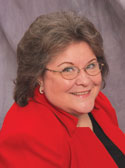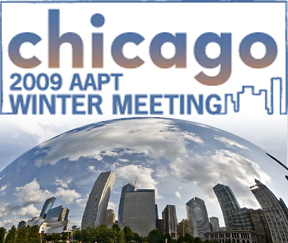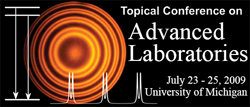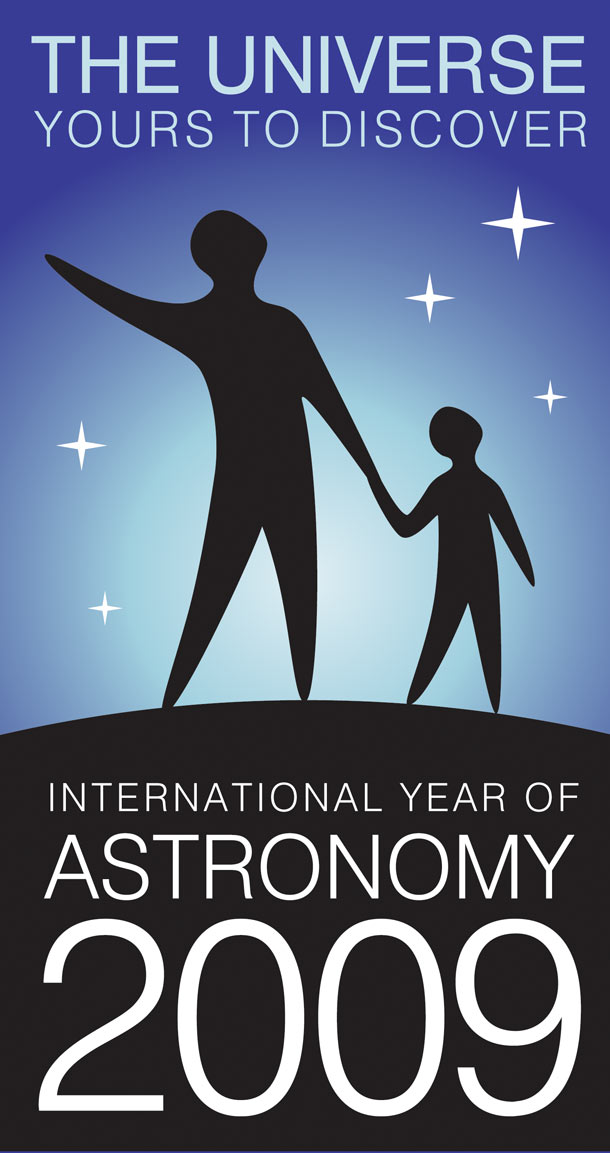eNNOUNCER February 2009
 Presidential Farewell
Presidential Farewell
As her presidential year ends Lila Adair shares her feelings about AAPT, how we did in 2008 and says thank you to all the people who supported her and made her presidential year such a pleasure. You can read her farewell in the AAPT February 2009 Announcements.
New Member and Journal Subscriber Benefit
Did you know that AAPT has implemented a new Table of Contents Alert (TOC) system for The Physics Teacher (TPT) and American Journal of Physics (AJP)? Be the first to know when a new issue of either TPT or AJP is posted online.
Sign up for AAPT TOC Alerts today!
2009 AAPT Winter Meeting in Conjunction with the AAAS Annual Meeting
 We hope that you will join us in Chicago for the 2009 Winter Meeting. Online Registration is still available.
We hope that you will join us in Chicago for the 2009 Winter Meeting. Online Registration is still available.
Al Gore,Former U.S. Vice President and Nobel Peace Prize Recipient is scheduled to speak 6:30 – 7:30 on Friday, February 13th.
Awards
George F. Smoot III will be accepting the Oersted Medal and Vera Rubin the Richtmyer Award. Smoot shares the 2006 Nobel Prize in Physics with John Mather and Vera Rubin received the National Medal of Science in 1993.
The 2009 Symposium on Physics Education
“Early High School Physics: Building a Foundation for Understanding the Sciences” will be conducted by a distinguished panel and moderated by Nobel Laureate, Leon Lederman. The Symposium is scheduled from 1:30 to 3:30 p.m. on Sunday, February 15th during the Winter Meeting.
The AAPT Winter Meeting Job Fair is scheduled for February 13-14, 2009.
Connecting
For the Winter ’09 meeting, AAPT is, for the first time, offering conference attendees a social networking tool that connects attendees to each other. Using SquareHive, an internet-based tool, you will be able to see who is already registered for the Winter ’09 meeting and interact with your colleagues before and during the conference. Watch for more details as AAPT develops this capability for your benefit.
Check the events calendar for future meetings.
PHYSICSBOWL 2009
Attention: High School Physics Teachers!
Enter your students in PHYSICSBOWL 2009 and receive national recognition for your school, your students, and your teaching excellence.
The PHYSICSBOWL is a competition where high school students compete for valuable awards and gifts. It is a 40-question, multiple-choice, 45-minute timed test, supervised by the school and administered throughout the country each year.
Team America Rocketry Challenge: Do You Have a Winning Lesson Plan?
The American Association of Physics Teachers (AAPT), in cooperation with the Team America Rocketry Challenge (TARC), is interested in identifying best practices for implementing model rocketry into both the formal instructional classroom as well as the informal activities of clubs such as the 4-H, Boy & Girl Scouts, and other after school programs. AAPT invites you to participate in the 2009 TARC lesson plan Contest. Submit your lesson plans or similar documents describing your team’s activities, planning, and experiments undertaken while preparing for the 2009 TARC competition and you could win a prize!
Physics Day at Six Flags America
Join us for hands-on learning, thrills and fun on April 24, 2009! Convert potential energy into kinetic energy, illustrate the vector addition of forces, compute centripetal accelerations and experience thrilling free falls and near weightless conditions during this exclusive event designed just for you. Students who think about and experience physics first hand develop a deeper understanding of the principles taught in the classroom. By becoming part of the laboratory equipment, your students will experience the excitement and FUN of understanding physics concepts. Find out more and get your tickets now!
2009 AAPT Topical Conference on Advanced Labs
 The Topical Conference on Advanced Labs will take place before the summer meeting on July 23-25, 2009 at the University of Michigan. This two and a half day meeting will cover techniques, experiments, and curricular ideas for post-introductory undergraduate labs, whether they are independent or tied to a lecture course. The conference will include invited speakers on a variety of topics, presentations by commercial vendors, and lots of opportunities for hands-on experiences with experimental equipment. For more information, please go to http://advlabs.aapt.org/
The Topical Conference on Advanced Labs will take place before the summer meeting on July 23-25, 2009 at the University of Michigan. This two and a half day meeting will cover techniques, experiments, and curricular ideas for post-introductory undergraduate labs, whether they are independent or tied to a lecture course. The conference will include invited speakers on a variety of topics, presentations by commercial vendors, and lots of opportunities for hands-on experiences with experimental equipment. For more information, please go to http://advlabs.aapt.org/ OSA Partnership Benefits Over 300 AAPT High School Teacher Members
Early in 2009, over 300 AAPT High School Teacher members will each receive an Optical Society (OSA) telescope kit and teacher guidebook as part of an OSA/AAPT collaboration. The OSA proposed the collaboration with AAPT this fall while the OSA Foundation was seeking high school teachers to whom they might award optics-based hands-on activity kits. What’s the catch? There isn’t one, except for feedback to OSA on the effectiveness of the kits. The evaluation process is important to OSA to continue to improve the kits for future classroom visits.
AAPT Executive Officer, Warren Hein, was excited about the opportunity to partner with OSA to provide these materials to pre-college teachers. “I am pleased that OSA came to AAPT and that we were able to partner with OSA to provide AAPT high school teacher members with new hands-on activities for the classroom at no cost – a great fund stretcher in these difficult economic times.”
OSA Chief Executive Officer Elizabeth Rogan explained, “Students are fascinated by the fact that they can actually build their own telescope. Providing hands-on optics materials to educators is one of the 115 programs the OSA Foundation supports, and advancing youth science education is a key goal. If you are interested in supporting this effort, please consider a donation www.osa.org/aboutosa/foundation.”
The OSA elves were expecting 100 responses from AAPT and were surprised when the list kept growing as AAPT members kept responding. So the hunt is on for the additional funding to fulfill every request. That also means that 200 extra kits have to be organized and assembled. Thanks OSA for the extra work and for helping AAPT teachers introduce the world of optics to a new generation of informed citizens!
Research Experiences for Teachers
PTEC, a project led by AAPT, the American Physical Society, and the American Institute of Physics, maintains a list of Research Experiences for Teachers, or RETs. These programs give in-service teachers an opportunity to spend part of their summer participating in cutting-edge physics research. The teachers are then able to take the knowledge they gain through these experiences back to their classrooms. In addition, RETs can help create valuable partnerships between universities and local schools.
If you would like to find an RET site near you, check out the PTEC RET map at http://www.ptec.org/rets/map.cfm.
Funding for the RET program comes from the National Science Foundation.
PTEC 2009: The Fifth Annual Physics Teacher Education Coalition Conference
The annual Physics Teacher Education Coalition (PTEC) Conference is the only national event in the country dedicated to physics and physical science teacher preparation. The 2009 PTEC Conference will take place in Pittsburgh on March 13 and 14, directly before the APS March Meeting. The conference will explore the theme of Institutional Transformation: How do we change departments and universities to embrace the mission of preparing tomorrow’s teachers?
Presenters will include faculty who run teacher preparation programs at their institutions, directors of national teacher preparation initiatives, and educational innovators who are developing leading science curricula and teaching methods.
The conference will also feature three highly regarded plenary speakers:
- Don Langenberg - Chancellor Emeritus, University System of Maryland;
- Phil Sadler - Director, Science Education Department, Harvard-Smithsonian Center for Astrophysics;
- Linda Slakey - Director of the Division of Undergraduate Education, National Science Foundation.
Two post-conference workshops on the morning of Sunday, March 15 will feature leaders in science education at the undergraduate level:
- Ed Prather, Department of Astronomy, University of Arizona; How to implement proven interactive learning strategies into the lecture portion of your classroom
- Valerie Otero, School of Education, and Steve Pollock, Department of Physics, University of Colorado at Boulder; Transforming your undergraduate physics course using Learning Assistants
These workshops will also be open to APS March Meeting attendees who do not attend the full PTEC Conference.
There will be a contributed poster session. Titles and abstracts are due February 27, 2009.
For more information: Please see www.PTEC.org/conferences/2009 or contact Gabe Popkin at popkin@aps.org.
About PTEC:
The Physics Teacher Education Coalition (PTEC) is a network of over 115 institutions committed to improving the education of future physics and physical science teachers. It is part of the PhysTEC project, which is led by the American Physical Society, the American Association of Physics Teachers, and the American Institute of Physics. For information about joining PTEC, please go to www.PTEC.org/join.
PhysTEC Noyce Scholars
If you’re looking for an exciting and challenging career where you can really make a difference, consider becoming a physics teacher. Physics teachers expose young minds to the wonders of nature and touch hundreds of young lives every year. Unfortunately, millions of children around the country don’t get to learn physics from a highly qualified teacher. Now, you can be that teacher. The PhysTEC Noyce Scholarship program can help.
PhysTEC Noyce Scholarships are available to future physics teachers at any of the six PhysTEC Noyce sites: Ball State University, Cornell University, Seattle Pacific University, the University of Arkansas, the University of North Carolina, and Western Michigan University. Scholarship support of up to $15,000 per year is available to junior and senior undergraduates, and post-baccalaureate students pursuing teaching certification, for up to two years per student. For each year of scholarship support, recipients commit to teach for two years in a “high need” school after graduation.
AAPT is proud to co-sponsor this scholarship program. Check out the PhysTEC Noyce webpage for additional information and application materials.
Physics to Go
Physics to Go is a collection of websites where you can learn physics on your own, through games, webcasts, and online exhibits and activities. Also included are physics on the road programs, which bring demonstration shows, and in some cases hands-on activities, to you, the audience. To find the resources you want, you can browse the collection and search our database by content topic, resource type, and grade level.
We encourage your involvement in Physics To Go. Once you have registered and signed in, which requires only a your name, email address and password, you can build a personal collection, share your comments about resources already in the comPADRE collection, and suggest resources for us to add.
AAPT Members in the News
Seeing the Invisible
Del Huston, AAPT member and Parkland High School science teacher, is responsible for cutting-edge cosmic ray detection machinery being in the school. A muon is something like an electron, both subatomic particles, but they’re rarer here on earth, as they come in from the upper atmosphere; their origins appear to be supernovas and similar astronomical events. They travel into class at the speed of light and, although they’re more particles than rays, the research is often referred to as cosmic ray detection.
“If your hold out your hands, a muon might pass through every minute,” said Dr. Del Huston. He indicated three hanging markers that indicate the location of the detection machinery. “These let us see the invisible.” That suitcase-sized box actually holds electronics that are designed to use GPS technology for extremely accurate timing of the muon appearances. “It’s from an atomic clock, and timed to a billionth of a second, a nanosecond. The timing is precise,” said Huston. More...
AAPT Member Earns National Board Certification
AAPT member Jaunine Fouche recently earned National Board Certification. [Original Article at Happy News]
AAPT Member Will Travel to South Pole
AAPT member Casey O’Hara will travel to the South Pole during the 2009-2010 winter (austral summer) to take part in the construction of IceCube (www.icecube.wisc.edu). O’Hara is a Knowles Science Teaching Foundation Fellow and National Board Certified physics teacher at Belmont, California’s Carlmont High School. [via PR Newswire]
AAPT in the News
Student Teams Shooting for Team America Rocketry Challenge Final.
New SSP Fellows Program
Society for Science & the Public (SSP), with generous support from Intel, is pleased to announce the launch of its Fellows Program. The SSP Fellows Program provides funds and training to selected U.S. science and math teachers who serve under-resourced students, to enable interested and motivated students to perform high-quality independent scientific research.
The SSP Fellows Program will attract the most creative and motivated high school science and math teachers in the country. Through a competitive selection process, the Program will provide teachers the financial and training resources necessary to support and inspire the success of their most enthusiastic science students. Fellows may serve for up to four years. The goal is to enable Fellows to guide students to produce project-based research of the highest quality, such as is selected for SSP’s premiere science competition, the Intel Science Talent Search.
ELIGIBILITY:
- Demonstrated interest in research but actual research experience not required.
- Active engagement in 9-12 grade science or if not actively teaching at this time, must demonstrate access to students to mentor.
- Teaching credential.
- Must be from a school that has enrollment that is at least 40% underrepresented minority and/or with at least 30% of students qualified for free or reduced rate lunches.
- Demonstrated evidence of engagement with students (e.g. participation in field trips, science clubs, science fair, mentorship activities; support of independent research).
- Excellent written and oral communication skills.
- Must be able to attend Fellows Institute in Washington DC – July 27 through July 31, 2009.
STIPEND:
Fellows receive a stipend of up to $8500/year depending on proposed budget, demonstrated need, support of the school and needs of the student population.
Deadline for application to the 2009 Fellows Program will be February 15, 2009 at 5:00pm EST. Successful applicants will be notified on March 5, 2009.
For information about the Fellows Program please visit: http://outreach.societyforscience.org/
Center for Research and Education in Optical Sciences and Applications Summer 2009 Research Internship
Physics, engineering, biophotonics, mathematics, and/or computer science majors in the 2nd-4th year of their programs with a 3.0 GPA or higher are invited to apply for this 8 week (6/8/09-7-31-09) internship on the campus of Delaware State University. Projects include Data Mining, Optical Solitons, Laser Spectroscopy, Bioimaging, and Atom Photonics in state-of-the-art research laboratories. Contact: Shonda Poe, Assistant to the Director at spoe@desu.edu.The CREOSA Internship Application is online at http://www.creosa.desu.edu/. Deadline is March 6, 2009.for more information.
McAuliffe-Shepard Discovery Center
New England’s Only Air and Space Science Center Opens March 6, 2009
CONCORD, NH (January 12, 2009) Be inspired, have fun and learn something new, in the spirit of Christa McAuliffe and Alan Shepard. A new full-service science center, the McAuliffe-Shepard Discovery Center, opens on March 6, 2009. With a Mercury-Redstone rocket at the front entry and a prominent observatory dome, New England's first air and space science center will make its home in Concord, NH, housing 45,000-square-feet of new interactive science exhibits, an expanded gift shop, café, and theater space. The new Discovery Center is a major transformation of the Christa McAuliffe Planetarium. The first phase of this transformation comes after ten years of planning and development.
The McAuliffe-Shepard Discovery Center is a lively educational science center featuring 21st century interactive exhibits on aviation, astronomy, and Earth and space sciences, a state-of-the-art planetarium and a variety of science and engineering programs.
The engaging, robust educational programs are geared towards families, teens, seniors, students, community groups, and lifelong learners of all ages. The Discovery Center will also offer space for conferences and special events, and a NASA Educator Resource Center.
The 45,113 -square-foot science center, quadruple the size of the original Christa McAuliffe Planetarium, was designed by Dignard Architectural Services of New Boston, NH. The principal of the firm, Roger Dignard, was lead architect on the original planetarium building when he worked for Lavallee-Brenginger in Manchester, NH.
Visitors to the Discovery Center will be greeted by an outdoor 92-foot-tall Mercury-Redstone rocket. The interactive, multi-sensory exhibit surrounding it tells the story of New Hampshire hero Alan Shepard, his historic flight as the first American in space on May 5, 1961, and the story of the Space Race that inspired much of our current aerospace initiatives and high technology spin-offs.
The Discovery Center will be constantly evolving. The completion of the first phase of development marks the beginning of the transformation. New simulation experiences and interactive exhibits will be added to the science center periodically over the coming months and years. Future additions include a Challenger Learning Center, simulated flight school, interactive exhibits and engaging programs on the physics of the universe, as well as traveling exhibits from science centers across North America.
The McAuliffe-Shepard Discovery Center honors the legacies of two New Hampshire heroes and is a place for visitors to explore, discover, and be inspired. As the only air and space science center in New England it welcomes all ages to have fun while learning about the universe in which we live. The new McAuliffe-Shepard Discovery Center features 21st century interactive exhibits on aviation, astronomy, and Earth and space sciences, a state-of-the-art planetarium and a variety of engaging programs. More information at www.starhop.com.
International Year of Astronomy
 The International Year of Astronomy 2009 is a global effort initiated by the International Astronomical Union and UNESCO to help the citizens of the world rediscover their place in the Universe through the day- and night-time sky, and thereby engage a personal sense of wonder and discovery.
The International Year of Astronomy 2009 is a global effort initiated by the International Astronomical Union and UNESCO to help the citizens of the world rediscover their place in the Universe through the day- and night-time sky, and thereby engage a personal sense of wonder and discovery.
Everyone should realize the impact of astronomy and other fundamental sciences on our daily lives, and understand how scientific knowledge can contribute to a more equitable and peaceful society. To help coordinate this huge global program and to provide an important resource for the participating countries, the IAU has established an IYA2009 website (www.astronomy2009.org) as the principal resource for public, professionals and media alike.
Science at the White House
Free Lesson Plans, Teacher Resources and Student Activities included.
In this activity from the American Association for the Advancement of Science’s Science NetLinks, students view a video of President-elect Obama discussing plans to hold White House events on such topics as space exploration and physics to raise awareness of the importance of science and inspire a sense of discovery. Students then participate in an online poll to offer topic suggestions.
Education News Documents Changes in Science Teaching—And Learning!
Check out this RSS feed we found on TEAL and Eric Mazur.
Education News
About AAPT NEWS
AAPT NEWS is a service to members of the American Association of Physics Teachers and is produced by the AAPT Central Office. All issues are archived here. Other stories of significance appear in our Announcements Archive and our archive of Press Releases. E-mail news items, comments, and suggestions to: news@aapt.org
Deliverability of this publication depends on your email address being current. If you have recently changed providers, jobs, or schools, please update your profile online at www.aapt.org as soon as possible. Adding ennouncer@aapt.org to your address book will also help ensure that your copy is delivered to your mailbox.
Note on External Links
Links to non-AAPT sites are intended as a service to readers interested in AAPT, physics, and education. These links do not reflect an endorsement of any content or product. Also, due to the evolving nature of websites, some external links referenced in the eNNOUNCER may expire over time.
Thanks for your readership and your support of AAPT.
Copyright © 2009, American Association of Physics Teachers



